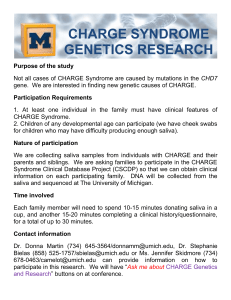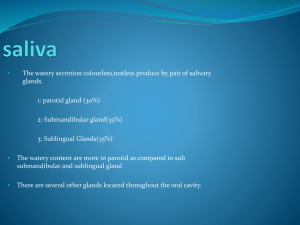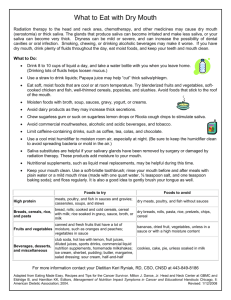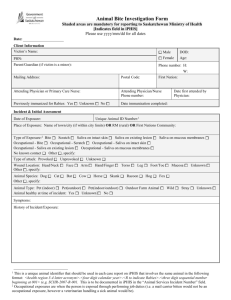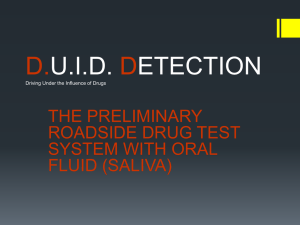click here - Home Health UK
advertisement
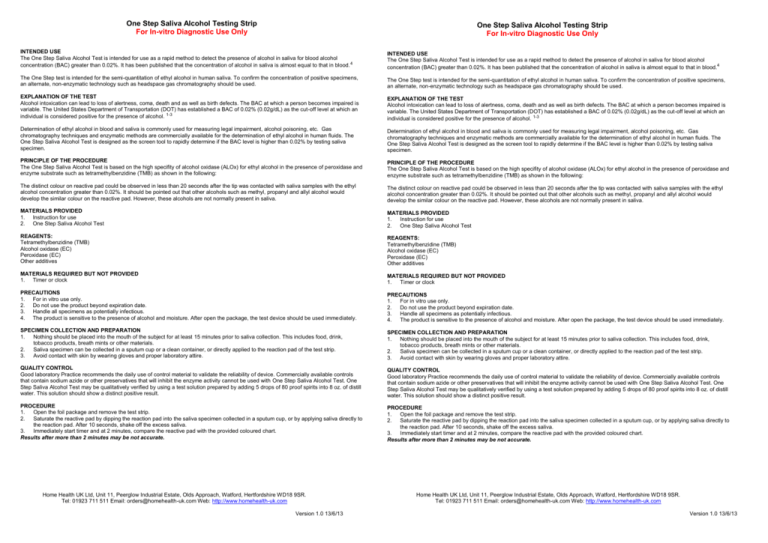
One Step Saliva Alcohol Testing Strip For In-vitro Diagnostic Use Only One Step Saliva Alcohol Testing Strip For In-vitro Diagnostic Use Only INTENDED USE The One Step Saliva Alcohol Test is intended for use as a rapid method to detect the presence of alcohol in saliva for blood alcohol concentration (BAC) greater than 0.02%. It has been published that the concentration of alcohol in saliva is almost equal to that in blood. 4 INTENDED USE The One Step Saliva Alcohol Test is intended for use as a rapid method to detect the presence of alcohol in saliva for blood alcohol concentration (BAC) greater than 0.02%. It has been published that the concentration of alcohol in saliva is almost equal to that in blood.4 The One Step test is intended for the semi-quantitation of ethyl alcohol in human saliva. To confirm the concentration of positive specimens, an alternate, non-enzymatic technology such as headspace gas chromatography should be used. The One Step test is intended for the semi-quantitation of ethyl alcohol in human saliva. To confirm the concentration of positive specimens, an alternate, non-enzymatic technology such as headspace gas chromatography should be used. EXPLANATION OF THE TEST Alcohol intoxication can lead to loss of alertness, coma, death and as well as birth defects. The BAC at which a person becomes impaired is variable. The United States Department of Transportation (DOT) has established a BAC of 0.02% (0.02g/dL) as the cut-off level at which an individual is considered positive for the presence of alcohol. 1-3 EXPLANATION OF THE TEST Alcohol intoxication can lead to loss of alertness, coma, death and as well as birth defects. The BAC at which a person becomes impaired is variable. The United States Department of Transportation (DOT) has established a BAC of 0.02% (0.02g/dL) as the cut-off level at which an individual is considered positive for the presence of alcohol. 1-3 Determination of ethyl alcohol in blood and saliva is commonly used for measuring legal impairment, alcohol poisoning, etc. Gas chromatography techniques and enzymatic methods are commercially available for the determination of ethyl alcohol in human fluids. The One Step Saliva Alcohol Test is designed as the screen tool to rapidly determine if the BAC level is higher than 0.02% by testing saliva specimen. Determination of ethyl alcohol in blood and saliva is commonly used for measuring legal impairment, alcohol poisoning, etc. Gas chromatography techniques and enzymatic methods are commercially available for the determination of ethyl alcohol in human fluids. The One Step Saliva Alcohol Test is designed as the screen tool to rapidly determine if the BAC level is higher than 0.02% by testing saliva specimen. PRINCIPLE OF THE PROCEDURE The One Step Saliva Alcohol Test is based on the high specifity of alcohol oxidase (ALOx) for ethyl alcohol in the presence of peroxidase and enzyme substrate such as tetramethylbenzidine (TMB) as shown in the following: PRINCIPLE OF THE PROCEDURE The One Step Saliva Alcohol Test is based on the high specifity of alcohol oxidase (ALOx) for ethyl alcohol in the presence of peroxidase and enzyme substrate such as tetramethylbenzidine (TMB) as shown in the following: The distinct colour on reactive pad could be observed in less than 20 seconds after the tip was contacted with saliva samples with the ethyl alcohol concentration greater than 0.02%. It should be pointed out that other alcohols such as methyl, propanyl and allyl alcohol would develop the similar colour on the reactive pad. However, these alcohols are not normally present in saliva. The distinct colour on reactive pad could be observed in less than 20 seconds after the tip was contacted with saliva samples with the ethyl alcohol concentration greater than 0.02%. It should be pointed out that other alcohols such as methyl, propanyl and allyl alcohol would develop the similar colour on the reactive pad. However, these alcohols are not normally present in saliva. MATERIALS PROVIDED 1. Instruction for use 2. One Step Saliva Alcohol Test MATERIALS PROVIDED 1. Instruction for use 2. One Step Saliva Alcohol Test REAGENTS: Tetramethylbenzidine (TMB) Alcohol oxidase (EC) Peroxidase (EC) Other additives REAGENTS: Tetramethylbenzidine (TMB) Alcohol oxidase (EC) Peroxidase (EC) Other additives MATERIALS REQUIRED BUT NOT PROVIDED 1. Timer or clock MATERIALS REQUIRED BUT NOT PROVIDED 1. Timer or clock PRECAUTIONS 1. For in vitro use only. 2. Do not use the product beyond expiration date. 3. Handle all specimens as potentially infectious. 4. The product is sensitive to the presence of alcohol and moisture. After open the package, the test device should be used immediately. PRECAUTIONS 1. For in vitro use only. 2. Do not use the product beyond expiration date. 3. Handle all specimens as potentially infectious. 4. The product is sensitive to the presence of alcohol and moisture. After open the package, the test device should be used immediately. SPECIMEN COLLECTION AND PREPARATION 1. Nothing should be placed into the mouth of the subject for at least 15 minutes prior to saliva collection. This includes food, drink, tobacco products, breath mints or other materials. 2. Saliva specimen can be collected in a sputum cup or a clean container, or directly applied to the reaction pad of the test strip. 3. Avoid contact with skin by wearing gloves and proper laboratory attire. SPECIMEN COLLECTION AND PREPARATION 1. Nothing should be placed into the mouth of the subject for at least 15 minutes prior to saliva collection. This includes food, drink, tobacco products, breath mints or other materials. 2. Saliva specimen can be collected in a sputum cup or a clean container, or directly applied to the reaction pad of the test strip. 3. Avoid contact with skin by wearing gloves and proper laboratory attire. QUALITY CONTROL Good laboratory Practice recommends the daily use of control material to validate the reliability of device. Commercially available controls that contain sodium azide or other preservatives that will inhibit the enzyme activity cannot be used with One Step Saliva Alcohol Test. One Step Saliva Alcohol Test may be qualitatively verified by using a test solution prepared by adding 5 drops of 80 proof spirits into 8 oz. of distill water. This solution should show a distinct positive result. QUALITY CONTROL Good laboratory Practice recommends the daily use of control material to validate the reliability of device. Commercially available controls that contain sodium azide or other preservatives that will inhibit the enzyme activity cannot be used with One Step Saliva Alcohol Test. One Step Saliva Alcohol Test may be qualitatively verified by using a test solution prepared by adding 5 drops of 80 proof spirits into 8 oz. of distill water. This solution should show a distinct positive result. PROCEDURE 1. Open the foil package and remove the test strip. 2. Saturate the reactive pad by dipping the reaction pad into the saliva specimen collected in a sputum cup, or by applying saliva directly to the reaction pad. After 10 seconds, shake off the excess saliva. 3. Immediately start timer and at 2 minutes, compare the reactive pad with the provided coloured chart. Results after more than 2 minutes may be not accurate. PROCEDURE 1. Open the foil package and remove the test strip. 2. Saturate the reactive pad by dipping the reaction pad into the saliva specimen collected in a sputum cup, or by applying saliva directly to the reaction pad. After 10 seconds, shake off the excess saliva. 3. Immediately start timer and at 2 minutes, compare the reactive pad with the provided coloured chart. Results after more than 2 minutes may be not accurate. Home Health UK Ltd, Unit 11, Peerglow Industrial Estate, Olds Approach, Watford, Hertfordshire WD18 9SR. Tel: 01923 711 511 Email: orders@homehealth-uk.com Web: http://www.homehealth-uk.com Version 1.0 13/6/13 Home Health UK Ltd, Unit 11, Peerglow Industrial Estate, Olds Approach, Watford, Hertfordshire WD18 9SR. Tel: 01923 711 511 Email: orders@homehealth-uk.com Web: http://www.homehealth-uk.com Version 1.0 13/6/13 INTERPRETATION OF RESULTS Negative: Almost no colour change by comparing with the background. The negative result indicates that the BAC is less than 0.02%. Positive: A distinct colour developed all over the pad. The positive result indicates that the BAC is 0.02% or higher. Invalid: The test should be considered invalid If only the edge of the reactive pad turned colour that might be ascribed to insufficient sampling. The subject should be re-tested. INTERPRETATION OF RESULTS Negative: Almost no colour change by comparing with the background. The negative result indicates that the BAC is less than 0.02%. Positive: A distinct colour developed all over the pad. The positive result indicates that the BAC is 0.02% or higher. Invalid: The test should be considered invalid If only the edge of the reactive pad turned colour that might be ascribed to insufficient sampling. The subject should be re-tested. LIMITATION OF PROCEDURE The One Step Saliva Alcohol Test is designed for use with human saliva only. A positive result indicates only the presence of alcohol and does not indicate or measure intoxication. There is a possibility that technical or procedure error as well other substances in certain foods and medicines may interfere with the test and cause false results. Please refer to “Interfering substances” section for list of substances that will interfere with the test results. LIMITATION OF PROCEDURE The One Step Saliva Alcohol Test is designed for use with human saliva only. A positive result indicates only the presence of alcohol and does not indicate or measure intoxication. There is a possibility that technical or procedure error as well other substances in certain foods and medicines may interfere with the test and cause false results. Please refer to “Interfering substances” section for list of substances that will interfere with the test results. EXPECTED RESULTS The One Step Saliva Alcohol Test is a semi-quantitative assay. It identifies alcohol in human saliva at a concentration of 0.02% BAC. EXPECTED RESULTS The One Step Saliva Alcohol Test is a semi-quantitative assay. It identifies alcohol in human saliva at a concentration of 0.02% BAC. PERFORMANCE CHARACTERISTICS The detection limit on the One Step Saliva Alcohol Test is from 0.02% to 0.3% for approximate relative blood alcohol level. The cut-off level of the One Step Saliva Alcohol Test can vary based on local regulations and laws. Test results can be compared to reference levels with colour chart on the foil package. PERFORMANCE CHARACTERISTICS The detection limit on the One Step Saliva Alcohol Test is from 0.02% to 0.3% for approximate relative blood alcohol level. The cut-off level of the One Step Saliva Alcohol Test can vary based on local regulations and laws. Test results can be compared to reference levels with colour chart on the foil package. ASSAY SPECIFICITY The One Step Saliva Alcohol Test will react with methyl, ethyl and allyl alcohols. ASSAY SPECIFICITY The One Step Saliva Alcohol Test will react with methyl, ethyl and allyl alcohols. INTERFERING SUBSTANCES The following substances may interfere with the One Step Saliva Alcohol Test when using samples other than saliva. The named substances do not normally appear in sufficient quantity in saliva to interfere with the test. INTERFERING SUBSTANCES The following substances may interfere with the One Step Saliva Alcohol Test when using samples other than saliva. The named substances do not normally appear in sufficient quantity in saliva to interfere with the test. A. Agents which enhance colour development Peroxidases Strong oxidizers A. Agents which enhance colour development Peroxidases Strong oxidizers B. Agents which inhibit color development Reducing agents: Ascorbic acid, Tannic acid, Pyrogallol, Mercaptans and Tosylates, Oxalic acid, Uric acid. Bilirubin L-dopa L-methyldopa Methampyrone B. Agents which inhibit color development Reducing agents: Ascorbic acid, Tannic acid, Pyrogallol, Mercaptans and Tosylates, Oxalic acid, Uric acid. Bilirubin L-dopa L-methyldopa Methampyrone REFERENCES; 1. National highway traffic safety administration NHTSA), DOT, Federal Register. 59:147, August 1994, pp 22382-90 2. Bergemeyer, H.U., et.al, Methods of Enzyme Analysis, 3rd ed. Vol. II, 1983, p143 3. Jones A.W., Clin. Exp. Pharmacol. Physiol. Vol. 6, 1979, pp 53-59 4. McCall K.E.L., et.al, Clin. Sce. Vol. 56, 1979, pp 283-286 REFERENCES; 1. National highway traffic safety administration NHTSA), DOT, Federal Register. 59:147, August 1994, pp 22382-90 2. Bergemeyer, H.U., et.al, Methods of Enzyme Analysis, 3 rd ed. Vol. II, 1983, p143 3. Jones A.W., Clin. Exp. Pharmacol. Physiol. Vol. 6, 1979, pp 53-59 4. McCall K.E.L., et.al, Clin. Sce. Vol. 56, 1979, pp 283-286 Home Health UK Ltd, Unit 11, Peerglow Industrial Estate, Olds Approach, Watford, Hertfordshire WD18 9SR. Tel: 01923 711 511 Email: orders@homehealth-uk.com Web: http://www.homehealth-uk.com Version 1.0 13/6/13 Home Health UK Ltd, Unit 11, Peerglow Industrial Estate, Olds Approach, Watford, Hertfordshire WD18 9SR. Tel: 01923 711 511 Email: orders@homehealth-uk.com Web: http://www.homehealth-uk.com Version 1.0 13/6/13
